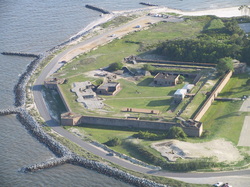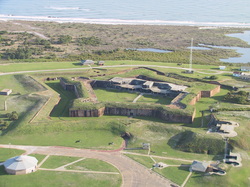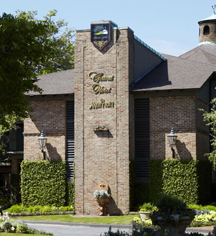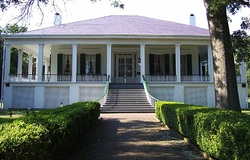ADMIRAL RAPHAEL SEMMES CAMP #11
SONS OF CONFEDERATE VETERANS
MOBILE, ALABAMA
Fort gaines

Fort Gaines, Dauphin Island, Alabama
Fort Gaines, located on Dauphin Island existed in different forms long before the War between the states. It was named for General Edmund Pendleton Gaines who had died in 1849. The fort played a crucial role in the battle for Mobile Bay. Visit the website.
Fort morgan

Fort Morgan, Alabama.
(Edibobb - April 10, 2002)
Significant in the naval battle that opened Mobile Bay to the Union Navy and sealed off the port of Mobile to Confederate shipping. There is slow but steady deterioration of the fort's masonry. Visit the website.
Your browser does not support viewing this document. Click here to download the document.
Historic Blakeley State Park
This park is minutes from Mobile. In addition to beautiful surroundings of the forest and Blakeley river, one can tour the battlefield, breastworks and fortifications for both Confederate and Union forces. There are miles of walking and biking trails.
Visit the website.
Visit the website.
Magnolia Cemetery, Mobile, al

Nestled in the heart of the historic district of Mobile, Alabama is the 100 acre cemetery that served as the primary and almost exclusive burial place of the city's notables during the nineteenth century. In addition to the Hunley Monument, the gravesite of General Braxton Bragg, and the family burial sites of many men who fought for the Confederate States of America, the cemetery includes Mobile's Confederate Rest - the gravesides of hundreds of Southern Soldiers. The Raphael Semmes Camp #11 helps to maintain this hallowed ground. Information, including the cemetery's history may be found on its website.
The History Museum of Mobile

The History Museum of Mobile is a repository of all things Mobile. There are many artifacts from the Old South from before, during, and after the War between the States. The 32 pounder cannon salvaged from the CSS Alabama is on permanent display. Tours are available, and history buffs can arrange private sessions to view and research the artifacts not on display. Visit the website.
The Grand hotel, fairhope, al

The Grand. Original burned down in 1869.
During the War between the States, the hotel began its military ties. As Alabama was one of the remaining Confederate strongholds during the Civil War, the port in Mobile was a popular spot for blockade runners. During the infamous 1864 battle between the Confederates and the Union, led by Admiral Farragut - in which he famously proclaimed “damn the torpedoes, full speed ahead” – the confederates bombarded the Union soldiers, eventually sinking the Tecumseh.
Yet, Admiral Farragut did not give up and eventually the Union forced Fort Morgan to surrender and then took over the Mobile port, closing it to blockade runners. In fact, Farragut fired upon the Grand Hotel. A large hole was found in the wall of the Gunnison House, located on the site of the Convention Center today. Despite all this, the city of Mobile remained in Confederate hands until 1865. It was during this time that the hotel was turned into a base hospital for Confederate soldiers. It was guarded by the 21st Alabama Infantry.
300 Confederate soldiers died while at the hospital, and are buried on the on-site cemetery, Confederate Rest. The soldiers were buried shoulder-to-shoulder, in mass graves. In 1869 a fire destroyed the documents that identified the deceased and a monument to the unknown was later constructed at the cemetery, which still stands today.
Yet, Admiral Farragut did not give up and eventually the Union forced Fort Morgan to surrender and then took over the Mobile port, closing it to blockade runners. In fact, Farragut fired upon the Grand Hotel. A large hole was found in the wall of the Gunnison House, located on the site of the Convention Center today. Despite all this, the city of Mobile remained in Confederate hands until 1865. It was during this time that the hotel was turned into a base hospital for Confederate soldiers. It was guarded by the 21st Alabama Infantry.
300 Confederate soldiers died while at the hospital, and are buried on the on-site cemetery, Confederate Rest. The soldiers were buried shoulder-to-shoulder, in mass graves. In 1869 a fire destroyed the documents that identified the deceased and a monument to the unknown was later constructed at the cemetery, which still stands today.
Beauvoir

Beauvoir House before Hurricane Katrina.
The home of Jefferson Davis, the president of the Confederate States of America. The home in Mississippi is open for tours. The Presidential Library is on the grounds of the home.
Visit the website,
Visit the website,